Podcast: Play in new window | Download (30.6MB)
Subscribe: Apple Podcasts | Spotify | Amazon Music | Android | Pandora | iHeartRadio | JioSaavn | Podcast Index | Email | TuneIn | RSS | More
By Davy Crockett
You can read, listen, or watch
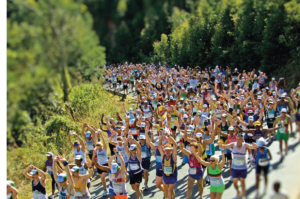 The Comrades Marathon (about 55 miles), held in South Africa, is the world’s largest and oldest ultramarathon race that is still held today with fields that have topped 23,000 runners.
The Comrades Marathon (about 55 miles), held in South Africa, is the world’s largest and oldest ultramarathon race that is still held today with fields that have topped 23,000 runners.
The year 2021, marked the 100th anniversary of Comrades Marathon “The Ultimate Human Race.” Comrades today is one of the most paramount ultrarunning events on the international calendar. It has a rich 100-year history packed with amazing accomplishments by more than 400,000 finishers through the years. How did it start and what kept it going for a century? This episode will cover the first two years of the race in 1921 and 1922.
| New Book! Classic Ultramarathon Beginnings Read about the early history of Comrades and other classic Ultramarathons. Available on Amazon. |
Vic Clapham
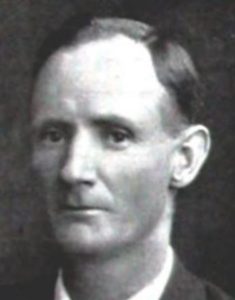

As a youth, Clapham attended Wynberg Boy’s High School, one of the best academic schools in Cape Town, and second oldest in South Africa. He would often walk about eight kilometers to school each day from his home. Usually he was given a three-penny “tickey” each day to pay for a train ride home so he could help in his father’s grocery store. Once he spent the money on sweets and instead walked back home. That resulted in a beating from his grandmother, and he never repeated that offence.
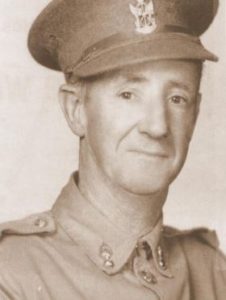

The Idea for Comrades Marathon
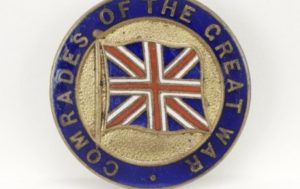

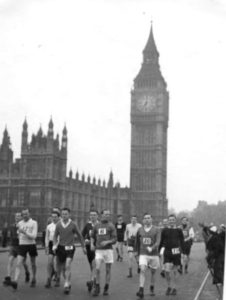

Clapham approached the League of Comrades about the idea in 1918 but received no support. They thought that the idea was crazy, far too strenuous for even trained runners. But he did not give up over the next several years, and eventually received approval for the event to be held in 1921. The League wanted their name associated with the event and sponsored it by lending Clapham one pound sterling which needed to be repaid.
Comrades Marathon Planning
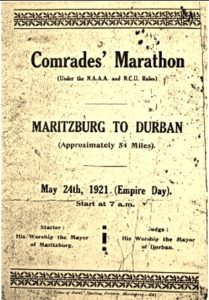

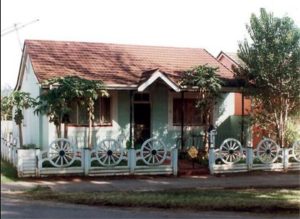

Clapham’s son, Eric, gave assistance in those early years. He wrote, “Runners would descend on our home before the race. My dad, an arch-scrounger, got donations of tea, milk and biscuits for all. I would have to give up my bed and sleep on the floor so a runner could have a comfortable night’s rest. On the morning of the race, my brother Douglas would have to cycle around Maritzburg at 4.30 a.m. in the freezing air with notebook and pencil to rouse the local runners. Each had to sign he’d been wakened. My mother would fry thick steaks on the coal stove in the kitchen. Each runner would get a massive steak topped with a couple of eggs for breakfast.”
The runners were told that during the race they could receive refreshments from certain hotels along the route. An interesting feature involved a letter of greetings from the mayor of Pietermarizburg to the mayor of Durban, which was to be carried by the runner in the lead.
The Comrades Marathon Course
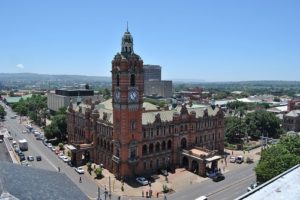

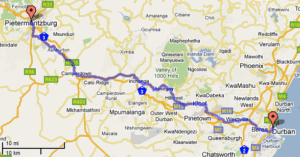

The course is sometimes referred to as “the five big hills.” With barely a single continuous mile of flat road, it can best be described as mountainous instead of hilly. In the early years, it truly was a mountain trail ultra. There was no concept yet of an “up year” or “down year”, but 1921 was on the “down” course direction with still about 2,500 feet of climbing. In the following years, the course direction mostly alternated each year.
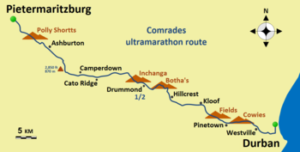

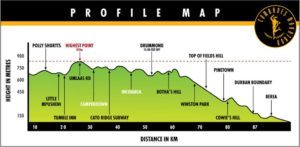

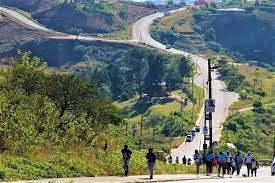

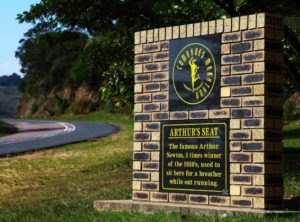

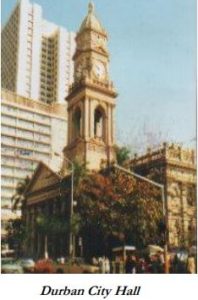

The 1921 Comrades Marathon
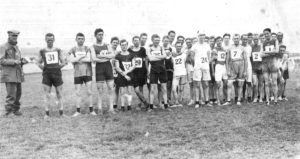

Historian John Cameron-Dow wrote, “The race, in an important sense, belongs to the people of KwaZulu-Natal. Right from the first race in 1921, the local population have made it their event. Lining the route, they are just as much part of Comrades as the athletes. The interaction between runner and spectator is the very essence of the race.”
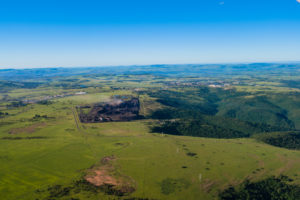

Butcher Purcell of Greytown took the early lead, crossing the bridge over Umsinduzi River first. He was challenged by Harry Phillips, of Marizburg and Bill Rowan, age 26, a farmer from Koster in the Transvaal.
“Leaving the city, a dusty sand road meandered over the hills and through the valleys all the way to Durban. Purcell, Phillips and Rowan were still together at Cato Ridge, but by the foot of Inchanga, Purcell had fallen two minutes behind.”
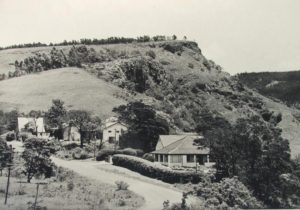

The halfway mark was reached at the sleepy little village of Drummond. Rowan, who had been pacing himself well went into the lead, followed by a convoy of bicycles, motorcycles and cars. He maintained and increased his lead over Phillips who was suffering from a chronic knee injury.
With about eighteen miles to go, he had built up a two-mile lead on Phillips. A motorist on the road reported, “Rowan’s a marvel. He was running splendidly when I saw him.”
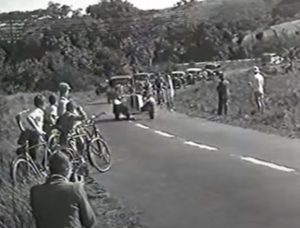

In later years, farmers set up aid station along the route and picnic parties were held by spectators who also handed out food to the runners.
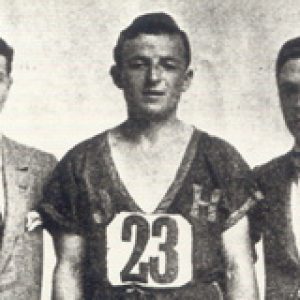

During the race, Vernon Jones, age 12, a future Comrades historian was camping with boy scouts along the road. He recalled, “As the cars approached, I was able to make out the figure of a bedraggled runner, caked with sand, Bill Rowan.”
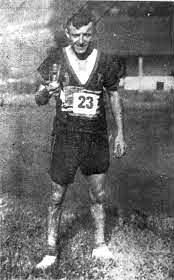

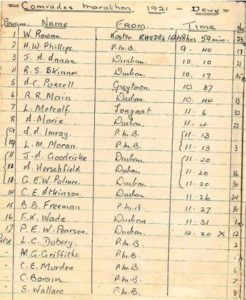

Arthur Newton brings Comrades into the Limelight


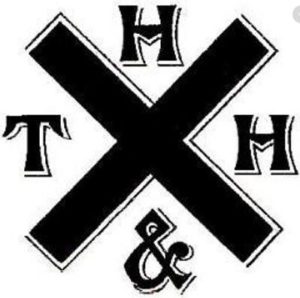

He came up with a bizarre idea. He decided that his route to fame was to become an elite runner. He believed, “Genuine amateur athletics were about a wholesome as anything on earth. Any man who made a really notable name at such would always be given a hearing by the public. I took up long-distance running solely with the object of focusing public attention on the treatment to which I had been subjected.” He set his sights to win the new Comrades Marathon.
Training for 1922 Comrades
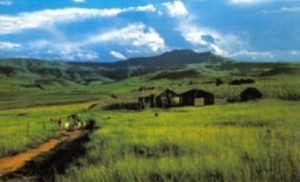

In preparing for the 1922 Comrades race, Newton, established a serious training program using any literature he could find on the subject. This ultra-distance would be much further than his cross-country races of previous years and he believed he was old, so thought it would be hard on him.
He knew that the 1921 winner, Rowan had trained doing 20-mile runs on his farm. But when Newton tried to run instead of walk, he would end up very stiff and out of breath. He finally admitted to himself that if he was to succeed, he would have to put aside his smoking after 20 years of the habit. He finally decided to allow himself two pipes a day including a post-run pipe as a reward for hard training.
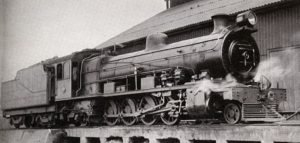

Newton went away from his time-trials, ignoring his watch. Instead, he concentrated on distance, not speed. He discovered the benefit of the long, slow run. His runs worked up to 25 miles and he dropped his weight by ten pounds to 132 pounds. After more than a month, he returned to race that train again and beat it. It was his longest run during his training, and he knew that he was almost ready.
1922 Comrades
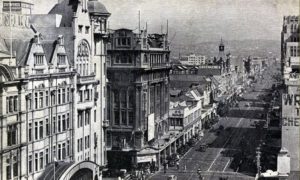

More than 100 men entered the second Comrades race to be held on May 24, 1922. They came from all walks of life, with some experienced runners. A few days before the race, Newton traveled to Durban on the train and did some light running to stay loose. He slept very little the night before the big day, being nervous and restless. “When I arrived at the starting point early in the morning, I kept away from the great bulk of the competitors so as to be able to sit quietly and rest instead of being called upon to talk loudly amidst the general bustle and noise.”
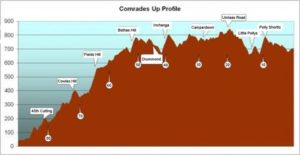

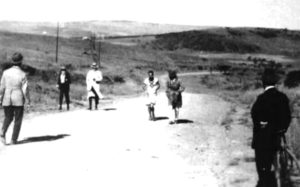

By mile 30, Newton passed the previous year winner, Rowan, who went out too fast and was battling cramps. Only three other men were ahead. The race director, Clapham received word that an unknown runner “77” was among the front-runners. He said, “There was a scramble for programmes to see who this number 77 was. It turned out to be a chap called Newton, from Ihluku. All I could say about him was that he was a farmer.”
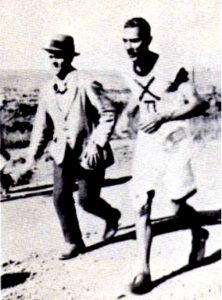

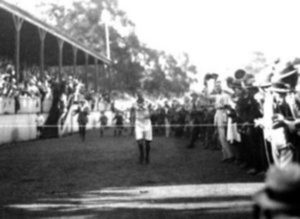

Newton wrote, “With a swarm of cars and cycles behind, I guessed there would be a crowd ahead. The moment I was sighted, I saw people beginning to run and in less than half a minute there was a dense crowd. The people swarmed up so suddenly from every side that I was only just able to get through with the aid of the police.” At the Sports Ground he ran on the track and thousands cheered him on as he ran the last stretch around the track. He said, “At last I saw the tape ahead and ran to it in a tumultuous roar and cheering from all sides to get a handshake from the city mayor.”
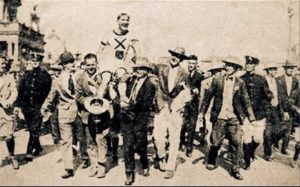

Newton told reporters that he did not think he would try to run that far again. “After all, I’m 39 and getting on in years.” Newton became a national celebrity overnight and went on to win Comrades four more times.
Later Years
The Comrades Marathon grew each year and eventually attracted international runners. Some Comrades history facts:
-

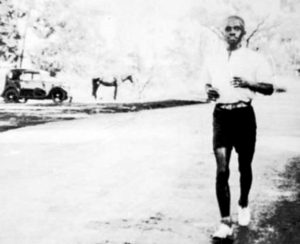
Robert Mtshali The first woman ran unofficially in 1923, Frances Hayward, who finished in 11:35.
- Robert Mtshali was the first unofficial black finisher in 1935 with a time of 9:30.
- Comrades was not held during World War II from 1941-1945.
- In 1948 a tradition began to start the race with a loud imitation of a cock’s crow instead of a pistol shot.
- Wally Hayward (1908-2006) became the first person to break the six-hour barrier in 1953 with a 5:52 finish.
- In 1962 the race started to attract foreign runners.
- In the 1970s the race had 3,000 runners and was widely broadcast on both radio and television.
- In 1975, blacks and women were finally allowed to officially run.
- Bruce Fordyce of South Africa won Comrades nine times, eight in a row during the 1980s. He has finished the race 30 times.
-

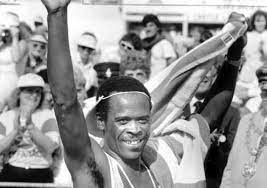
Sam Tshabalala Sam Tshabalala became the first black winner in 1989.
- For a time, Americans and others were not allowed to compete by running associations until apartheid was lifted in 1991.
- In 1995 cash prizes were introduced and the event became more commercialized. By 1996 it was the largest sporting event in South Africa.
- The largest race was in 2000, with a massive 23,961 runner field. An amazing 20,000 runners finished in the allowed 12 hours.
- In 2012, Antony Clapham, the great-grandson of the race founder successfully finished Comrades.
-

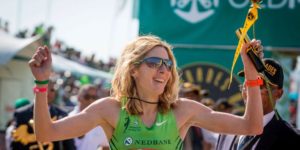
Camille Herron wins Comrades in 2017 There have been at least seven deaths during the race.
- American, Ann Trason won Comrades twice, in 1996 and 1997. In more recent years, Camille Herron won in 2017. She said it is “the ultimate race to do as an ultrarunner.”
- American ultrarunning legend, Dave Obelkevich, finished Comrades eleven times.
- Barry Holland and Louis Massyn of South Africa have 47 consecutive Comrades finishes, 1973-2019.
- As of 2021, Comrades has been held 94 times
Other articles about Comrades legends:
- 59: Arthur Newton
- 83: Hardy Ballington – The Forgotten Great Ultrarunner
- 84: Wally Hayward (1908-2006) – South African Legend
- 85: Mavis Hutchison – Galloping Granny
- 86: Jackie Mekler – Comrades Legend
Sources:
- John, Cameron-Dow, The Ultimate Human Race
- Morris Alexander, The Comrades Marathon Story
- “How it all began”
- The Ultimate Human Race
- Comrades History
- Arthur Newton, Running in Three Continents
- Rob Hadgraft, Tea with Mr. Newton: 100,000 Miles – The Longest ‘Protest March’ in History
- Mark Whitaker, Running for their Lives: The Extraordinary Story of Britain’s Greatest Ever Distance Runners
- Comrades Marathon turns 100 years old
- A Soldier’s Dream

